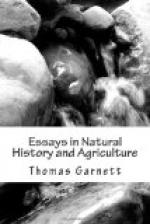I have shown that there were two migrations from the spawn of 1816; but this was not all—there still remained a few Smolts through the summer of 1819, which by that time were from four to six ounces in weight, and which are known by the anglers there as Brambling Smolts. The blue marks on their sides are very distinct, and the fish is a perfect Smolt, except that it is considerably larger. It is quite different from the Whitling, or Sprod, which is not known in the Wharfe, at least not in the upper parts of that river, whilst the Brambling is never seen in the Ribble. [1]
The Brambling is a beautiful fish, and it rises very freely both at the May fly and the artificial fly through the summer; it is occasionally caught by anglers with the worm on the Salmon spawning beds in the autumn, with the milt perfectly developed, and in a fluid state. Although this fish is not found in the Ribble, so far as my observations and inquiries have gone, I believe that it is found in the Tweed, and perhaps also in other rivers running into the German Ocean; for a letter addressed to Mr. Kennedy, who was chairman of the select committee appointed to investigate this subject, by a Mr. George Houy, states that the Smolts are sometimes found there ten inches long, which he attributes to their not being able to get down at the proper period for want of a flood in the river. But I know that in the Ribble Smolts will go down to the sea without there being a flood at all, if that does not come within ten days or a fortnight of the time at which they usually descend to the sea. I also know that Brambling are found in the Wharfe, in years where there has been no deficiency in that respect; yet why they should be common in that river, when they are never met with in the Ribble, which has ten times as many Salmon and Smolts in it, I am unable to comprehend.
It is my opinion that the ova of the Salmon are not hatched before March or April. Two anglers, who were in April wading in the river Wharfe, came upon a spawning bed, which they had the curiosity to examine; they found a number of ova, in which they could see the young fry already alive, and one of them took these eggs home with him. By regularly and frequently supplying them with fresh water, he succeeded in hatching them, and kept some of the young fishes alive for some time; but they died in consequence of neglect, and were even then very diminutive. The opinion




